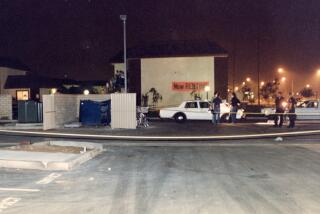Exclusive: Prosecutors hunt for DNA from dead killers, rapists
Opening a new frontier for solving cold cases, California prosecutors are hunting for DNA from killers, rapists and other prison inmates who died before authorities obtained their genetic profiles.
Prosecutors from Sacramento, Los Angeles and Orange counties are sifting through old court exhibits and examining long-since forgotten crime-scene evidence in search of blood, saliva and other material that can be tested for DNA. Once obtained, the DNA is compared with the genetic profiles from unsolved cases that have DNA from unidentified perpetrators.
Prosecutors say they believe the program is the first in the nation to target potentially thousands of offenders who have died in prison or while on parole before a biological sample could be tested for DNA as required by state law.
Last year, the program made its first cold-case hit after prosecutors discovered that coroner’s officials in Sacramento still had blood from an autopsy conducted on serial killer Juan Chavez, who hanged himself in Folsom Prison in 1999. Chavez pleaded guilty to robbing and strangling five middle-aged men in Los Angeles County in the mid- to late-1980s.
Once Chavez’s genetic profile was placed in the state’s DNA criminal databank, authorities found that it matched DNA on a cigarette butt left at the Westlake-area apartment of a man strangled in 1990.
Although such successes will not usually help with a criminal prosecution, officials involved in the program say that knowing the full extent of dead offenders’ crimes could help cold-case detectives avoid wasting time investigating other suspects and bring relief to crime victims and their families, who finally learn the truth about who was responsible.
“We owe it to these families — whether the person is dead or not — to provide the answers that they’re entitled to. That’s the primary goal,” said Anne Marie Schubert, a supervising deputy district attorney in Sacramento who is spearheading the effort.
Similar attempts to use DNA from the dead generally have been limited to isolated cases. Three months ago in Illinois, for example, the Cook County Sheriff’s Department announced that DNA from serial killer John Wayne Gacy had been added to the nation’s databank of criminal offenders to help determine whether he was responsible for other murders around the country.
But Schubert said she believed the California program is the first to seek genetic profiles for large numbers of convicted offenders who are dead.
The law on who must provide genetic samples for testing has evolved over the last three decades as DNA technology has improved. Today, the law applies to anyone arrested on suspicion of a felony. Prison officials take saliva swabs from all inmates when they arrive in custody.
Although DNA extraction from the living has long proven controversial among privacy rights advocates, Michael T. Risher, a staff attorney at the American Civil Liberties Union of Northern California who has litigated DNA privacy cases, said targeting dead inmates raises fewer privacy concerns.
Nevertheless, Risher said he would be concerned if prosecutors began trying to exhume bodies or seek blood or other samples provided during medical treatment. Going after medical samples, he said, could deter living inmates from seeking healthcare out of fear that what they provide to doctors could end up in the hands of law enforcement.
Veteran Los Angeles County prosecutor Carol Burke said she had considered whether hospitals might have samples that could help the program, but said privacy laws might make such attempts difficult. She said she and others would carefully consider the legal implications before trying such creative approaches.
“Emotionally, you want to react by saying, ‘Let’s get samples wherever we can, however we can.’ But we’re in a position here where we have to follow the law, and that’s what we’ll do,” she said.
The program has made obtaining genetic profiles of inmates who died while on death row a priority.
Burke, who heads the Los Angeles County district attorney’s sex-crimes division, said she personally tracked down biological samples from five death row inmates after they died.
Among them was Roland Norman Comtois, who was convicted of abducting two Chatsworth teenagers in 1987, killing one and leaving her friend for dead in an abandoned station wagon. Comtois died in 1994 from an infection following surgeries for chronic heart and bowel problems.
Burke said she was able to obtain his blood from clothes that Los Angeles police had kept after officers shot Comtois during his 1987 arrest in the slaying.
So far, however, DNA from Comtois and the four other Los Angeles County inmates who died on death row have not matched any profiles from unsolved cases.
“Even if we just get these few in, I think it’s worth the effort,” Burke said. “We solved one case, so to me that’s rewarding and worth my time.”
The searches often prove fruitless, with plenty of dead ends. Many times, prosecutors find that court exhibits have been destroyed, laboratory evidence has been thrown away, autopsies were not conducted or inmates were cremated.
Faced with such disappointments, prosecutors have tried to think of creative approaches, such as searching for envelopes from letters that inmates wrote to loved ones or to the court.
In Orange County, the district attorney’s office is preparing to send samples from two dead inmates to the state’s Department of Justice for testing in the next couple of weeks.
The office has assigned four volunteer law clerks and an investigative assistant to comb through court records and other evidence in search of samples that can be tested. They managed to find blood from the inmates and an envelope from a letter written by one of them, said Camille Hill, a senior deputy district attorney in the office’s DNA unit.
Schubert, the Sacramento prosecutor, said the key to success is not giving up.
“Everybody’s DNA is somewhere,” she said. “We’re going to have more success, but it’s a matter of time and persistence.”
ALSO:
Chef who killed wife, then cooked body to be sentenced
Bell trial: After mistrial, next steps for attorneys unclear
$2.5 million in cocaine found stashed in floor of big-rig trailer
More to Read
Sign up for Essential California
The most important California stories and recommendations in your inbox every morning.
You may occasionally receive promotional content from the Los Angeles Times.











